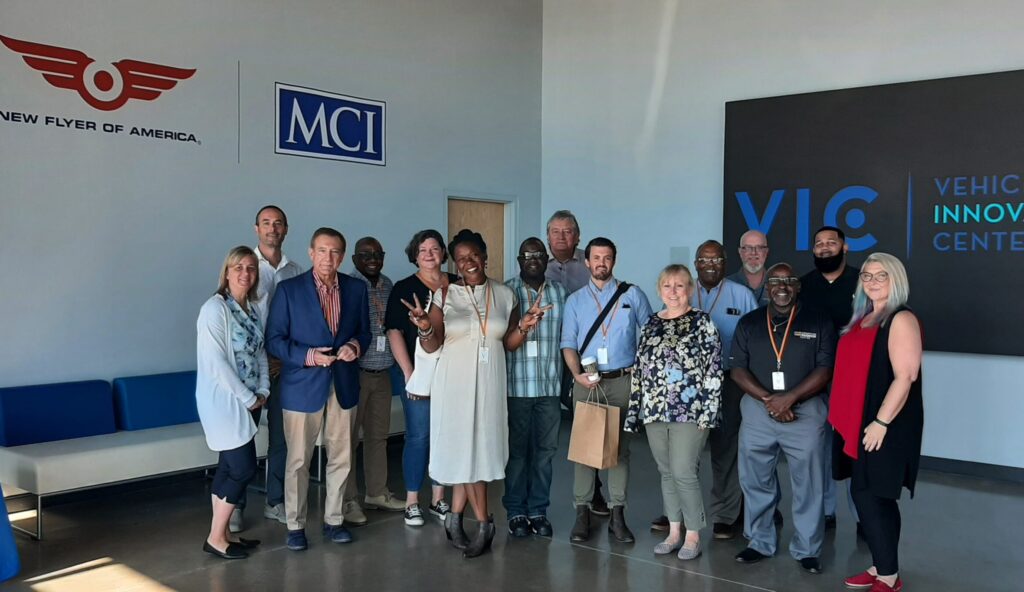
Community benefits agreements, once primarily used for real estate development projects, are increasingly used in the manufacturing space as a tool to ensure that public investments yield measurable results for the public. The case study by Athena Nicole Last, PhD, Senior Research Fellow for the Jay Mehta Community Benefits Agreement Resource Center, focuses on the 2022 multi-state community benefits agreement (CBA) signed between New Flyer, the largest electric transit bus manufacturer in North America; Jobs to Move America; and the Alabama Coalition of Community Benefits. The CBA encompasses New Flyer facilities in Anniston, Alabama and Ontario, California, but the report focuses on the Alabama facility.
What is a Community Benefits Agreement?
CBAs are defined as contracts with legally enforceable and accountable commitments, signed between community-labor coalitions and project owners.
Why Anniston?
This study focuses on a community benefits agreement in Anniston, Alabama, a racially and ethnically diverse city with half of the population identifying as Black. It has a poverty rate that is significantly higher than the national average and families of color disproportionately live in higher rates of poverty compared to white families in the area. The CBA aims to mitigate past social, economic, environmental and political harms affecting residents, and the agreement’s success challenges dominant narratives about what is possible in the South.
Report Summary
Focusing primarily on New Flyer’s Annison facility, the study details how a coalition of labor, community and advocacy groups negotiated the CBA, and how it supports the process of implementing resources to reduce barriers to employment, pre-apprenticeship programs, inclusive hiring practices, and a safe and inclusive workplace as outlined in the agreement.
Key findings
Community Benefits Agreements are a Mechanism for Equitable Development.
CBAs provide a replicable, legally enforceable framework for ensuring that public investments yield measurable benefits for historically disadvantaged workers and communities. The New Flyer CBA serves as a national model, showing how CBAs can counteract development practices that exploit workers and communities.
Labor-Community Coalitions Can Advance Economic Democracy.
The study demonstrates that democratic coalitions including labor unions, community organizations, and advocacy groups can meet global corporations at the table to negotiate complex agreements.
Innovations in Inclusive Workforce Development
The CBA’s inclusion of equitable training programs, employment practices that prioritize historically disadvantaged populations (e.g., targeted outreach/hiring goals and ban-the-box policies), and wraparound services like transportation stipends illustrate scalable approaches to bridging the skills gap and diversifying the workforce. These programs are especially effective at creating needed good job opportunities for formerly incarcerated or other individuals impacted by the justice system, women, people of color and other groups historically excluded from high-paying manufacturing and green economy jobs.
Southern Labor Organizing as a Site of Innovation
The success of the New Flyer CBA in Alabama highlights the South as the site of a worker-led movement, where coalitions are organizing in innovative ways to challenge the old playbook of how companies do business in the region. It also provides a counterpoint to right-to-work policy frameworks, demonstrating that worker power can still be built and sustained. The CBA is proof that companies don’t have to follow the so-called “Alabama discount” to be successful.
Public Subsidies Must Come with Public Accountability
The case study reveals how states and localities offer millions in subsidies to companies with little built-in accountability. CBAs represent a solution for communities to ensure that economic development policy benefits them.
Why this matters
As real wages decline, many workers have a dismal view of the U.S. economy. The government has attempted to spur an economic upsurge by offering corporations economic development incentives and subsidies to invest locally, yet wealth inequality and limited access to family-sustaining jobs persist. If the government continues to make significant investments in U.S. manufacturing, it’s crucial that these investments include commitments to the public.
Report recommendations
The study suggests that the CBA model can be replicated to promote equitable economic development while addressing the shortcomings of economic strategies prevalent in the South (“Alabama discount”). The report uplifts recommendations for negotiating CBAs, including:
- Research Community Needs: It is crucial for labor-community coalitions to conduct thorough research on community, worker, and employer needs, including surveys of workers and surrounding communities. This groundwork is essential in identifying key stakeholders and understanding community problems that CBAs can address.
- Educate Stakeholders: To garner support, it is recommended that organizations educate the community, corporations, and other stakeholders about the benefits of CBAs. Stakeholders should understand when CBAs can be utilized, how they function, and their potential advantages for all parties involved.
- Build a Diverse Coalition With an Inclusive, Democratic Structure: Authentic community engagement with stakeholders from various backgrounds is necessary to build trust and strengthen the coalition. An organizational structure that promotes strong participation from community members and workers should be established, ensuring that the process is democratic and equitable for all involved.
- Identify Non-Negotiables: Before negotiations, coalitions should clarify their top priorities and what provisions are non-negotiable to ensure unity and coherence during discussions with project owners.
- Ensure Attainability of Provisions: Provisions included in the CBA must be realistic and achievable for all parties. It is recommended to engage experts for guidance to ensure that these provisions can be effectively implemented.
- Include Transparency and Monitoring Mechanisms: CBAs should incorporate strong monitoring and evaluation measures to verify compliance and hold all parties accountable to their commitments.
- See CBAs as “Win-Win” Contracts: CBAs are a mutually beneficial contract for all parties involved. Equitable training and employment opportunities can benefit historically disadvantaged populations, while simultaneously building a workforce pipeline for companies.
Share this report using our digital toolkit.
For more information on the Jay Mehta Community Benefits Agreement Resource Center, visit the CBARC website.
